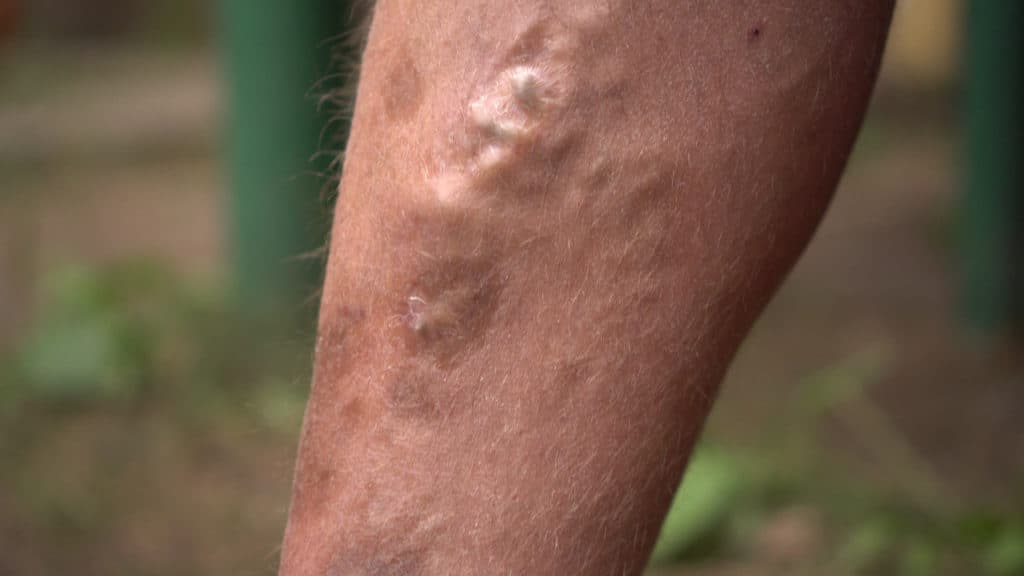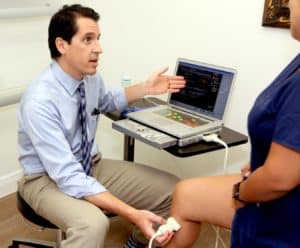What Are Varicose Veins?
Varicose veins are enlarged, twisted, and bulging veins caused by the valves in the veins no longer functioning properly. When the valves fail, blood flow goes bad and begins to pool, and pressure increases.
The increase in pressure causes the vein wall to bulge outwards, resulting in the telltale appearance of varicose veins. Varicose veins are most commonly found in your leg veins and can be painful, itchy, and unsightly. According to the American Heart Association, more than 30 million Americans suffer from varicose veins.
Risk Factors:
While anyone can develop varicose veins, some factors contribute to having a higher risk for vein disease:
- Obesity
- Genetics
- Smoking
- Pregnancy
- Physically inactive
- Over the age of 40
- Gender
- Have had a blood clot (DVT) in the past
- Regularly standing for extended periods
Why Should You Get Varicose Veins Treated?
Without treatment, varicose veins won’t go away on their own, and, unfortunately, varicose veins can worsen over time, even if you wear compression stockings daily. Contrary to common thought, varicose veins aren’t a cosmetic issue; they’re a health condition and can negatively impact a patient’s quality of life. If left untreated, the vein disorder can lead to problems such as:
- Pain
- Swelling
- Cramping
- Itching
- Skin discoloration
- Increased risk of blood clots
- Increased risk of ulcers in the veins
- Deep Vein Thrombosis
- Venous Insufficiency

How Can You Get Rid of Varicose Veins?
There are numerous options for treating varicose veins, some more invasive than others. Your physician can help determine which treatment strategy would work best for your condition and tailor a treatment protocol to suit your needs. Using ultrasound, your doctor can get a picture of what’s going on under the skin and how severe the vein disease is.
1. Sclerotherapy (injection)
A minimally invasive treatment, sclerotherapy involves injecting a chemical solution or foam directly into the affected vein to shrink and close it. This procedure is most successful on smaller varicose veins as well as spider veins. It takes less than thirty minutes to complete; however, it may take several sessions for the desired results.
2. Ambulatory phlebectomy (microphlebectomy)
Not to be confused with vein stripping, this minimally-invasive outpatient procedure involves small incisions in the leg to allow for vein sections to be removed. This procedure is often used for larger, painful, bulging veins that are closer to the skin. Because the vein is removed rather than treated (like with laser treatments), the relief is immediate. This procedure takes about thirty minutes, and you’ll leave without any stitches.
3. Radiofrequency ablation (RFA)
A form of thermal ablation, RFA uses a small wire that is inserted into the vein to emit electromagnetic radio waves to burn the vein, causing it to collapse. Local anesthesia is used, and relief is immediate. There is little to no downtime and minimal discomfort.
4. Laser ablation
Another form of thermal ablation, laser ablation, uses high-intensity beams of light to burn varicose veins and cause them to collapse. Laser therapy is effective at treating both superficial and deep veins. Similar to RFA, the downtime and discomfort is minimal.
5. Endovenous adhesive ablation
One of the more recently approved treatments, endovenous ablation uses a catheter to apply medical-grade adhesive (glue) into the faulty vein. Pressure is applied at specific intervals to seal the vein shut. There is no downtime involved. This procedure is effective with smaller varicose veins and doesn’t require wearing compression stockings afterward.
In the past, a more invasive technique called vein stripping was the only procedure available to treat varicose veins. Less invasive procedures have been developed since then, reserving vein stripping for cases where the varicose veins are larger or have the potential of hemorrhaging. Stripping removes the vein using a small wire inserted and guided through two incisions. Recovery can take several weeks, and pain medications will be prescribed.
Lifestyle Remedies
Although lifestyle changes can’t directly heal varicose veins, or at least have healthy veins, they can alleviate the symptoms and, in some cases, reduce the progression. These methods decrease the pressure and blood pool in the veins.
- Elevation of the leg
- Exercise
- Weight loss
- Quit smoking
- Compression stockings
Varicose veins don’t have to rule your life; there are many treatment options available today. If you’re suffering from varicose veins, or worry you don’t have healthy veins, the team at East Bay Vein Specialists is here to help you. Contact us today for a consultation to determine which treatment best suits your needs.
Sources
https://www.centerforvein.com/blog/how-common-are-varicose-veins
https://www.ahajournals.org/doi/10.1161/circulationaha.113.008331



